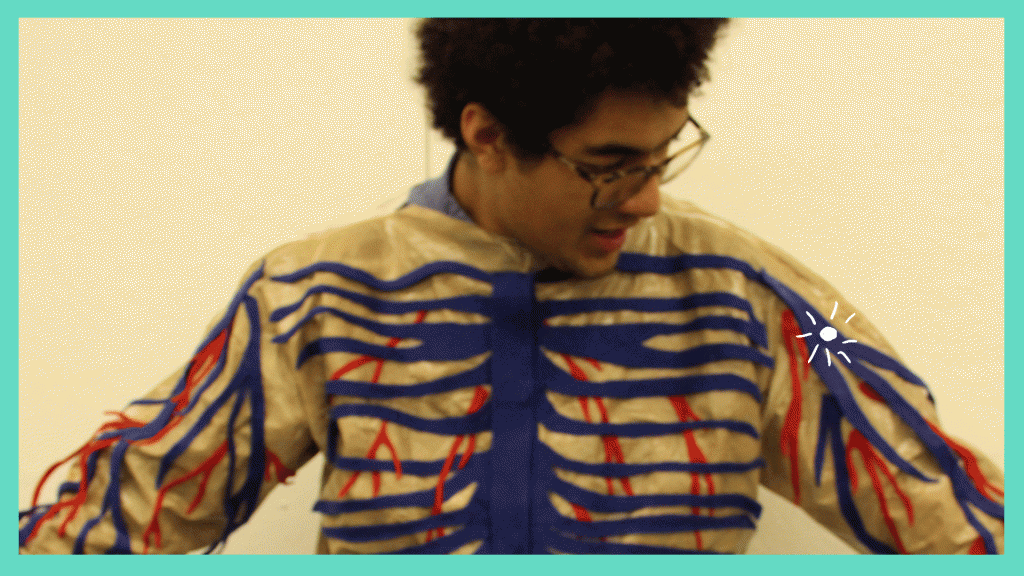Our final piece via gifs:
Final Proposal
Our group created a series of prosthetics designed specifically for those who are transitioning from high school to college, a time where significant strain is put on one’s relationships with friends and family who are away, and where one must work to forge friendships and collaborative partnerships with many people in a short amount of time.[1] Our prosthetics are designed for situations where two people of opposing views are unable to convey their ideas or understand the other person’s point of view. This problem is particularly relevant to this transition, as important conversations are put off until they can be held in person, or are had using less intimate and effective technology.[2] These prosthetics augment the users’ abilities to be empathetic, ultimately strengthening rather than damaging relationships, even when the two users are in different psychological and physical places.
The prosthetics are influenced by the designs of nineteenth century scuba suits, on an aesthetic as well as conceptual level, as the intent of scuba gear is to inhabit and understand something outside of human nature.[3] In the same way, our prosthetics allow people to explore and understand the ideas, emotions, and opinions of their friends and family that differ from their own.
The first prosthetic in our series is a full-body, tan jumpsuit with an external nervous system that creates a unified environment between the users while they are in separate places, in order to facilitate a shared emotional state. The suit, which uses heat sensing technology to interact with the body, allows for more accurate communication between the two users and ultimately a more empathetic response from each user.
Our second prosthetic in the series seeks to remove emotion from a conversation in order to make each user freer to express their ideas in a more objective manner. This prosthetic, a mouthpiece, inspired by the design of vocoder technology, changes the user’s tone, speed, and frequency of speech, allowing a discussion of opposing ideas to be more constructive, leading to an exchange of ideas rather than personal attacks.
The third prosthetic in our series, a headpiece that mimics elements of modern and antique diving gear[4], is intended for those who struggle to express their own emotions.[5] The prosthetic uses color to translate the user’s complex or overwhelming emotions into coherent thoughts, facilitating the respectful exchange of opposing ideas in a potentially heated or passionate debate.
Pioneer Works would be the ideal setting for our group to realize these designs. Although mockups have been made of each prosthetic in our series, certain facilities at Pioneer Works, such as 3D printers, would be vastly more efficient in creating these prosthetics than the material our group has been working with so far (namely, metal, paper, felt, and thin sheets of plastic). Furthermore, as a group we have done research on existing technology that could be integrated into each prosthetic, and are interested in further, more thorough explorations of technology that could make each prosthetic fully functional.
[1] Snow, Nancy. “Empathy” American Philosophical Quarterly Vol. 37 Jan. 2000: 65-78.
[2] Gilbert, Margaret. “Collective Guilt and Collective Guilt Feelings” The Journal of Ethics Vol. 6 No. 2, Collective Responsibility 2002: 115-143.
[3] Newitz, Annalee, and Charlie J. Anders. “The Strange and Wonderful History of Diving Suits, From 1715 to Today.” Io9. Accessed December 1, 2014. http://io9.com/the-strange-and-wonderful-history-of-diving-suits-from-1262529336
[4] Reckas, Ted. “In Depth: The Aquarius Helmet.” The Water Column. July 20, 2012. Accessed December 10, 2014. http://www.oneworldoneocean.com/blog/entry/in-depth-the-aquarius-helmet.
[5] Phillips, Louise H., Shelley Channon, Mary Tunstall, Anna Hedenstrom, and Kathryn Lyons. “The Role of Working Memory in Decoding Emotions.” Emotion 8, no. 2 (2008): 184-91. Accessed December 3, 2014. http://search.proquest.com/docview/614479537/abstract?accountid=12261

0 comments on “LIMBo: Communication” Add yours →